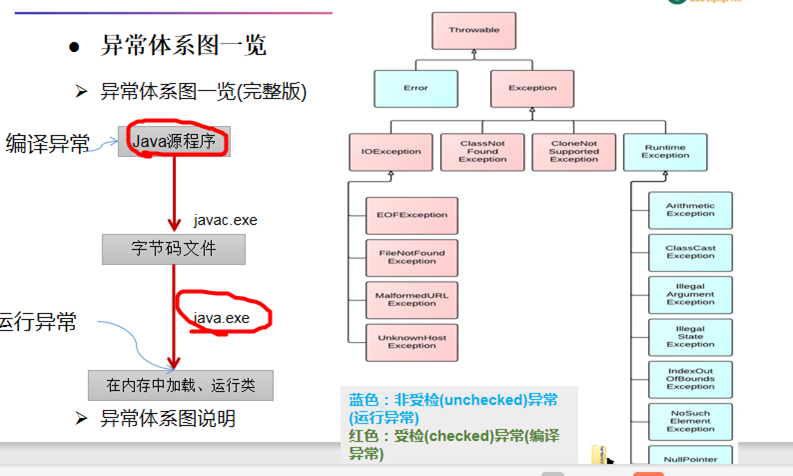Java基础之:异常及异常处理
我们将java程序执行过程中出现的不正常现象称为异常,例如:之前遇到的数组下标越界异常,空指针异常等等
执行过程中发生的异常事件分为两类:
Error(错误):Java虚拟机无法解决的严重问题,如:JVM系统内部错误,资源耗尽等严重情况。比如:StackOverFlowError(栈溢出),Error是严重错误,程序会直接崩溃掉。
Exception:其他因为编程错误或偶然的外在因素导致的一般性问题,可以使用针对性的代码进行处理。例如空指针访问等。Exception分为两大类:运行时异常(在程序运行过程中)、编译时异常(在程序编译过程中)


常见的运行时异常
NullPointerException:空指针异常
public class NullPointerException_ {
private static String str;
public static void main(String[] args) {
// TODO Auto-generated method stub
System.out.println(str.length());
System.out.println("hello~");
}
}
ArithmeticException:数学运算异常
当出现异常的运算条件时,抛出此异常。例如,一个整数“除以零”时,抛出此类的一个实例, 例如:int i = 10 / 0
ArrayIndexOutOfBoundsException:数组下标越界异常
public class ArrayIndexOutOfBoundsException_ {
public static void main(String[] args) {
int[] arr = {1,2};
System.out.println(arr[4]);
}
ClassCastException:类型转换异常
当试图将对象强制转换为不是实例的子类时,抛出该异常。例如,以下代码将生成一个 ClassCastException
public class ClassCastException_ {
public static void main(String[] args) {
Animal a = new Dog();
Cat cat = (Cat)a;
}
}
class Animal {
}
class Dog extends Animal {
}
class Cat extends Animal {
}
NumberFormatException:数字格式不正确异常
当应用程序试图将字符串转换成一种数值类型,但该字符串不能转换为适当格式时,抛出该异常 => 使用异常我们可以确保输入是满足条件数字.
public class NumberFormatException_ {
public static void main(String[] args) {
String name = "小范~";
int num = Integer.parseInt(name);
}
}
常见的编译时异常
SQLException //操作数据库时,查询表可能发生异常
IOException //操作文件时,发生的异常
FileNotFoundException //当操作一个不存在的文件时,发生异常
ClassNotFoundException //加载类,而该类不存在时,异常
EOFException // 操作文件,到文件末尾,发生异常
IllegalArguementException //参数异常
异常处理
异常处理就是当异常发生时,对异常处理的方式。
两种方式:
try-catch-finally
程序员在代码中捕获异常,并自行处理
throws
将发生的异常抛出给调用方,最顶级的调用方就是JVM
try-catch异常处理
Java提供try和catch块来处理异常。try块用于包含可能出错的代码。catch块用于处理try块中发生的异常。可以根据需要在程序中有任意数量的try...catch块。
基本语法:
try{
//可能出现异常的代码
//将异常生成对应的异常对象,作为参数传递给catch
}catch(异常对象){
//异常处理
}
public class Exception_ {
public static void main(String[] args) {
String a = null;
try {
System.out.println(a.length());
System.out.println(a);
} catch (Exception e) {
// TODO: handle exception
System.out.println(e.getMessage());
}
}
}
注意事项
如果异常发生了,则异常发生那条语句后面的代码不会执行,直接进入catch块
如果异常没有发生,正常执行try块,不会进入catch块
可以使用多个catch块,捕获不同的异常(进行不同的业务处理),要求父类异常在后面,子类异常在前面。例如: RuntimeException在后面,NullPointerException在前面。如果发生异常只会匹配一个catch。
try-catch-finally异常处理
相较于try-catch而言,多了一个finally块,它的作用是:不管有没有出现异常,都一定会执行finally块中的代码。
当然也可以使用try-finally,但这种方法和不处理异常是一样的,最后会让JVM机来处理异常。而JVM机处理异常的方式,就是直接输出异常信息然后终止程序。所以不建议这样使用。
try-catch-finally案例
public class try_catch_finally{
public static void main(String args[]){
int[] a = {1,2,3};
try{
System.out.println(a[4]);
}catch{
System.out.println("数组下标越界异常");
}finally{
System.out.println("finally块执行....");
}
}
}
程序输出:
数组下标越界异常
finally块执行....
练习题
考虑下面程序输出:
package class_exception;
public class Test {
@SuppressWarnings("finally")
public static int method() {
try {
String[] names = new String[3];
if (names[1].equals("john")) {// 空指针异常
System.out.println(names[1]);
} else {
names[3] = "lucy";
}
return 1;
} catch (ArrayIndexOutOfBoundsException e) {
return 2;
} catch (NullPointerException e) {
return 3;
} finally { // 一定要执行
return 4;
}
}
public static void main(String[] args) {
System.out.println(method());
}
}
练习题2
考虑程序输出:
package class_exception;
public class Test {
public static int method() {
int i = 1;
try {
i++; // 2
String[] names = new String[3];
if (names[1].equals("john")) { // 空指针异常
System.out.println(names[1]);
} else {
names[3] = "lucy";
}
return 1;
} catch (ArrayIndexOutOfBoundsException e) {
return 2;
} catch (NullPointerException e) {
return ++i; //提示:不是立即返回 记录 i= i+1 = 3 保存到 temp = 3
} finally {
++i;
System.out.println("i=" + i);
}
}
public static void main(String[] args) {
System.out.println(method());
}
}
应用案例
如果用户输入的不是一个正整数,就提示他反复输入,直到输入一个正整数为止
import java.util.Scanner;
public class ClassWork {
@SuppressWarnings("resource")
public static void main(String[] args) {
Scanner input = new Scanner(System.in);
int age;
System.out.println("输入年龄:");
for(;;) {
try {
age = new Scanner(System.in).nextInt();
break;
} catch (Exception e) {
System.out.println("再次输入年龄(正整数):");
continue;
}
}
System.out.println("END");
}
}
throws异常处理
如果一个方法(中的语句执行时)可能生成某种异常,但是并不能确定如何处理这种异常,则此方法应声明抛出异常,表明该方法将不对这些异常进行处理,而由该方法的调用者负责处理。
在方法声明中用throws语句可以声明抛出异常的列表,throws后面的异常类型可以是方法中产生的异常类型,也可以是它的父类。
import java.io.FileInputStream;
import java.io.FileNotFoundException;
public class Throws01 {
public static void main(String[] args) throws FileNotFoundException {
// 1. 使用try
// 2. 使用throws
m1();
System.out.println("ok");
}
public static void m1() throws FileNotFoundException {
FileInputStream fis = new FileInputStream("d://aa.txt");// 编译异常
}
}
使用细节:
对于编译异常,程序中必须处理,使用try-catch或throws
对于运行时异常,程序如果没有处理,默认就是throws方式处理,将其抛给最顶层调用方JVM
子类重写父类的方法时,对抛出异常的规定:子类重写的方法,所抛出的异常类型要么和父类抛出的异常一致,要么为父类抛出的异常的类型的子类型
在throws 过程中,如果有方法 try-catch , 就相当于处理异常,就可以不必throws
细节3案例:
class Father {
public void m1() throws RuntimeException{
}
}
class Son extends Father{
@Override
public void m1() throws NullPointerException{
}
}
自定义异常
定义类:自定义异常类名(程序员自己写) 继承Exception或RuntimeException
如果继承Exception,属于编译异常
如果继承RuntimeException,属于运行异常(一般来说,继承RuntimeException)
自定义异常应用案例
package class_exception.ClassCustomException;
import java.util.Scanner;
/**
* 当我们接收Person对象年龄时,要求范围在 1 – 130 之间,否则抛出一个自定义异常(要求 继承自定义异常)
*/
public class ClassWork01 {
public static void main(String[] args) {
Scanner scanner = new Scanner(System.in);
Person p = new Person();
System.out.println("请输入年龄:");
for(;;) {
try {
int a = scanner.nextInt();
p.setAge(a);
break;
} catch (Exception e) {
// TODO: handle exception
System.out.println(e.getMessage());
System.out.println("请重新输入年龄:");
continue;
}
}
}
}
class Person{
private int age;
public Person(int age) {
this.age = age;
}
public Person() {
}
//创建方法使用异常
public void setAge(int a) throws AException{
if(!(a>=0 && a<=130)) {
throw new AException("异常 要求范围在 1 – 130 之间");
}
}
}
class AException extends RuntimeException{
/**
* 添加版本号,不用管
*/
private static final long serialVersionUID = 1L;
//使用构造器传入异常信息
public AException(String name){
super(name);
}
}
自定义异常应用案例2
package class_exception.ClassCustomException;
import java.util.Scanner;
/**
* 编写应用程序,接收一个数,要求不能输入负数,进行异常处理。要求使用继承 RuntimeException 来实现,
*/
public class ClassWork02 {
public static void main(String[] args) {
Scanner s = new Scanner(System.in);
System.out.println("输入一个数:");
try {
int a = s.nextInt();
//因为是运行时异常,也可以不使用try处理
if(a<0) {
throw new IntException("不能输入负数");
}
}catch(RuntimeException e){
System.out.println("异常信息:" + e.getMessage());
}
System.out.println("END");
}
}
class IntException extends RuntimeException{
private static final long serialVersionUID = 1L;
public IntException(String name) {
super(name);
}
}
throw 和 throws 的区别






















 334
334











 被折叠的 条评论
为什么被折叠?
被折叠的 条评论
为什么被折叠?








